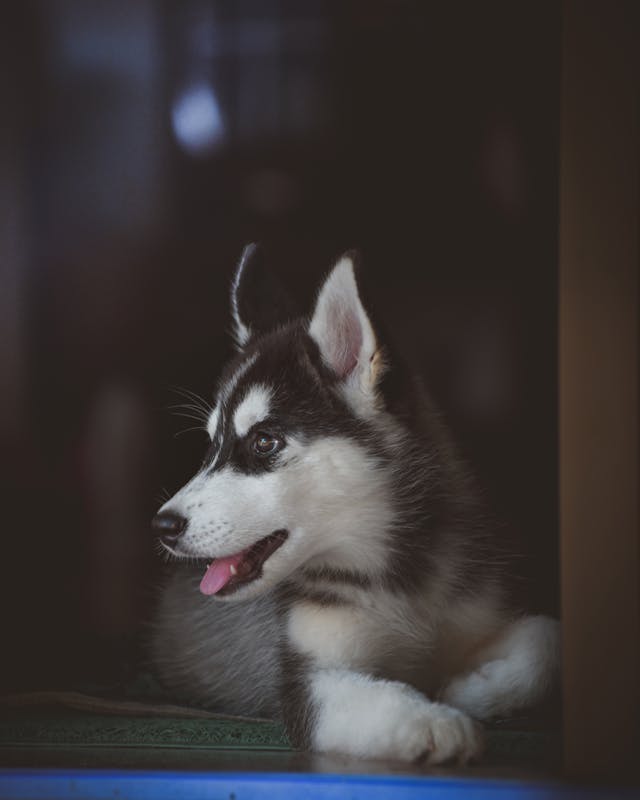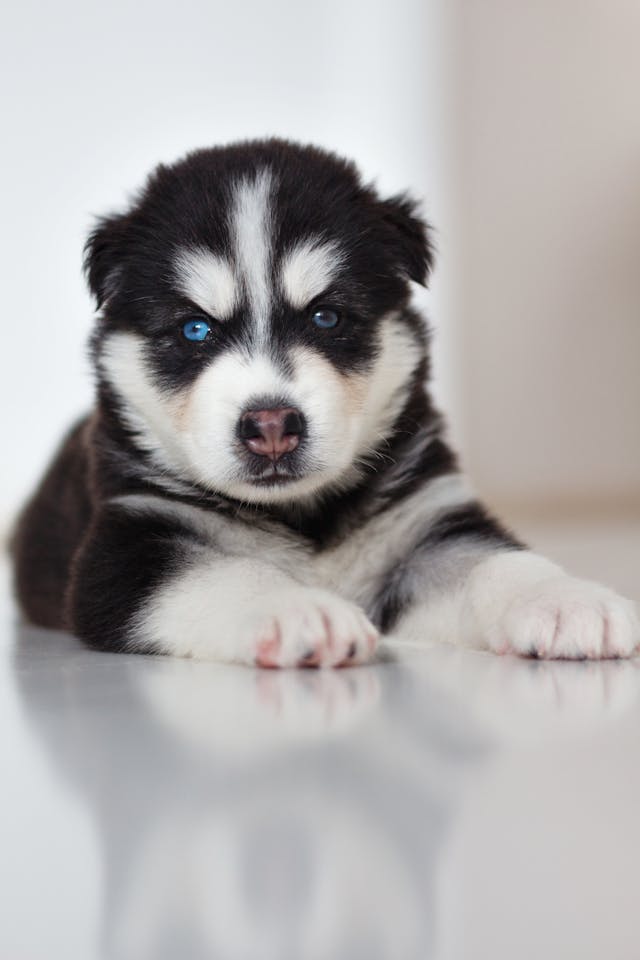Siberian Huskies are more than just pretty faces with striking blue eyes; they’re energetic, athletic, and packed with personality. If you’re considering adopting one of these remarkable dogs or already have one at home, understanding their size and growth is crucial. This knowledge helps you prepare for their care, feeding, and exercise needs, ensuring a happy and healthy life for your furry friend.
Table of Contents
These dogs’ medium size, strength, and adaptability make them one of the most popular breeds worldwide. However, their physical attributes go beyond looks. Their compact yet muscular frames were designed to thrive in extreme Arctic conditions, pulling sleds over vast distances with remarkable endurance. Let’s dive into the specifics of how big Siberian Huskies get and what influences their growth.

Average Size of Siberian Huskies
Siberian Huskies are classified as medium-sized dogs with a graceful and well-balanced build. Here’s what you can expect:
- Height: Male Huskies stand between 21 and 23.5 inches (53–60 cm) at the shoulder, while females are slightly smaller, measuring 20 to 22 inches (50–56 cm).
- Weight: Males typically weigh 45–60 pounds (20–27 kg), whereas females weigh 35–50 pounds (16–23 kg).
Their compact yet sturdy bodies were bred for endurance, enabling them to pull sleds over long distances in harsh Arctic conditions. Their size, though medium, allows them to move swiftly while conserving energy—a vital trait for survival in icy terrains.
Factors Influencing Their Size
The size of a Siberian Husky can vary due to several factors, making each dog unique. Here’s a closer look at what determines their physical growth:
- Genetics: A Husky’s lineage has the greatest influence. Dogs from working lines may be leaner and slightly smaller, while those bred for companionship might carry a bit more weight. If both parents are on the larger or smaller side, their puppies often follow suit.
- Diet and Nutrition: High-quality nutrition during growth stages ensures strong bones and muscles without unnecessary weight gain. Puppies require diets rich in protein, healthy fats, and essential vitamins to support rapid growth and development. Adult Huskies thrive on balanced meals that include lean proteins, complex carbohydrates, and omega-3 fatty acids for coat health. Overfeeding, especially during puppyhood, can lead to obesity and joint issues. Conversely, malnourishment can stunt growth, leaving the dog smaller and weaker than average. Always consult your veterinarian for personalized feeding guidelines.
- Exercise: Huskies are high-energy dogs. Regular activity helps maintain a healthy weight and supports muscular development. Without sufficient exercise, they may gain weight, leading to size and health concerns. Proper exercise routines include running, hiking, and interactive play sessions that challenge their physical and mental abilities.

Growth Stages of a Siberian Husky
Huskies experience distinct growth milestones that shape their physical and behavioral characteristics. Knowing these stages helps owners understand what to expect:
- Puppyhood (0–12 Months): Rapid growth occurs in the first year. Puppies often double in size within the first few months. They’re playful, curious, and require socialization to develop good behavior. At this stage, frequent vet checkups ensure they’re growing at a healthy pace.
- Adolescence (12–18 Months): Growth slows during this phase as they approach their adult height. They continue filling out in muscle mass and weight. Behavioral changes like increased independence or testing boundaries may also occur, requiring consistent training.
- Adulthood (2 Years and Beyond): By age 2, most Huskies are fully grown, with their weight stabilizing if they’re cared for properly. Adult Huskies are energetic, strong, and agile, reflecting their genetic heritage as working dogs.
When Does a Siberian Husky Stop Growing?
Most Huskies stop growing in height around 12 to 14 months, but their bodies may continue to mature and gain muscle until about 18 to 24 months. This gradual development ensures a strong and balanced adult physique. Owners should focus on maintaining a healthy diet and consistent exercise regimen during this phase to support their Husky’s full growth potential.
Siberian Husky Size and Growth Chart
Below is a detailed growth chart for Siberian Huskies, providing a general guideline to track your dog’s progress:
| Age | Weight Range (lbs) | Weight Range (kg) |
|---|---|---|
| 8 Weeks | 8–15 | 3.6–6.8 |
| 3 Months | 17–23 | 7.7–10.4 |
| 6 Months | 26–48 | 11.8–21.7 |
| 12 Months | 35–60 | 16–27 |

It’s important to remember that individual growth rates can vary based on genetics, diet, and activity levels. Slight deviations from this chart are normal, but significant differences may warrant a vet visit.
Male vs. Female Siberian Huskies
Male and female Huskies differ in size and build, with these variations often influencing their care needs:
- Males: Larger, more muscular, and heavier, ideal for strength-oriented tasks. They tend to have a commanding presence and may require additional calorie intake to support their larger frames.
- Females: Smaller, lighter, and often sleeker, with a more delicate frame. Their smaller size makes them slightly more agile, and they typically consume fewer calories than their male counterparts.
Understanding these differences helps owners provide tailored care, ensuring both genders thrive equally.
How to Measure Your Siberian Husky
Measuring your Husky is straightforward and an excellent way to monitor their growth and health. Follow these steps:
- Height: Use a tape measure from the ground to the highest point of their shoulders (the withers).
- Weight: Weigh yourself holding your Husky, then subtract your weight from the combined total.
- Length: Measure from the base of the neck to the base of the tail.
Record these measurements periodically, as they can help detect unusual growth patterns or weight changes early. This is particularly helpful during their puppy and adolescent stages.
Is a Siberian Husky a Good House Dog?
Yes, Siberian Huskies can thrive as house dogs—but only if their needs are met. These dogs are incredibly social and bond well with families. They do, however, require:
- Space: A fenced yard or access to outdoor areas is ideal for allowing them to stretch their legs.
- Exercise: At least 1–2 hours of physical activity daily to burn off their abundant energy. Long walks, runs, or play sessions help keep them happy and healthy.
- Mental Stimulation: Puzzle toys, training sessions, and interactive games keep them engaged and prevent boredom, which can lead to destructive behavior.
Without proper care, Huskies can become mischievous or overly vocal. They thrive in homes where their physical and mental needs are prioritized.

How Big Are Siberian Huskies When They Are Full Grown?
A fully grown Siberian Husky stands between 20 to 23.5 inches (50–60 cm) tall and weighs 35 to 60 pounds (16–27 kg). This size strikes a balance between agility and strength, making them well-suited for both family life and outdoor adventures.
Can a Siberian Husky Weigh 100 Pounds?
A purebred Siberian Husky weighing 100 pounds is highly unusual. This weight often indicates:
- Obesity: Excessive weight gain due to overfeeding or lack of exercise.
- Mixed Breeding: A mix with a larger breed can result in a heavier dog.
If your Husky approaches this weight, consult a veterinarian for advice to ensure their health and well-being.
Is a Husky a Large or XL Dog?
Siberian Huskies are considered medium-sized dogs. Their thick coats can make them appear larger, but their actual size places them firmly in the medium category. They’re built for endurance rather than sheer size, which is why they’re so agile and energetic.
What 8 Years in Husky Dog Years Means for Your Furry Friend
My Journey with Luna: Life Lessons from a Husky
5 Pit Bull Breeds: Info, Labels, and Recognized Groups
Bordeaux Pitbull Facts That Will Blow Your Mind!

